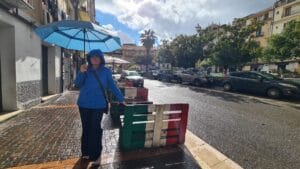
Lamezia Terme: The Blog That Nearly Didn’t Happen – By Andy
A2Z Wander | Our Blog A Rainy Arrival (and a Slight Hangover) Lamezia Terme almost didn’t get its own blog post. There’s only so many

Buongiorno, amici! That’s “good morning, friends” in Italian. I’ve been secretly learning on Dogolingo when no one’s watching. It’s important to try the local language, and honestly, the Italians seem to think I’m even more adorable when I do. Who am I to argue?
Turin has been wicked so far. We’re staying in a cool little area near the market called Borgo Dora—very vibrant, very lively, and full of fascinating smells. The streets around the market are a treasure trove of shops and cafés, reflecting the mix of cultures that call this place home. But our street? Oh, it’s extra special. It’s lined with laid-back bars (I’m not allowed to drink in them, but secretly I do!), quirky antique shops (very sniffable), and fancy design stores (which I am definitely not allowed in).
Now, let me tell you about the markets—a dog’s paradise. Every month, the Grand Balon takes over the streets with over 300 stalls and 50 shops selling antiques, vintage treasures, and collectables. Every Saturday there’s a famous flea market. I like to think of it as a giant treasure hunt, but apparently, I’m not allowed to take part. Something about “not everything is a chew toy.”

Even the dogs here are cool. Stylish, sophisticated, effortlessly nonchalant. I tried to impress them with my best doggie pose, but they just gave me an unamused look and continued on their way. Tough crowd.
There’s something different about Borgo Dora, something hard to put your paw on at first. But after a few hours, it’s obvious: the people here care. They care about their produce, their neighbourhood, and their community.
Just down our street, near the River Dora, we stumbled upon something truly special—an old munitions building (the first in Italy and used during the Italian Risorgimento and the Two World Wars) now transformed into a community cultural centre. Once a factory producing weapons, it’s now known as the Arsenal of Peace. An arsenal of war turned into an arsenal of hope. Even a little dog like me could feel the significance of that.
Originally built in 1580 as a gunpowder factory, this place later became the first weapons factory in Italy. For centuries, it supplied arms for wars, but in 1964, a group of people led by Ernesto Olivero came together with a simple but powerful goal: to defeat hunger and create a place of peace. What started with a small dream has grown into a global movement—today, the Arsenal of Peace supports over 3,400 projects across five continents and has led over 70 peacekeeping missions. Even Mother Teresa was so impressed that she nominated Ernesto Olivero for the Nobel Peace Prize.

And we discovered all of this by accident, on our night time walkiesl. We peeked through an open doorway and saw people gathered around a fire—young and old, from different backgrounds, sharing a moment together. No labels, no divisions—just people helping people. In a world that sometimes feels a little overwhelming, it was a humbling sight. A reminder that kindness still shines through.
 Borgo Dora isn’t just another cool neighbourhood in Turin—it’s a place where history, community, and heart come together. And, as a travelling pup with a keen eye for the special moments, I can confirm: this place is very, very special.
Borgo Dora isn’t just another cool neighbourhood in Turin—it’s a place where history, community, and heart come together. And, as a travelling pup with a keen eye for the special moments, I can confirm: this place is very, very special.
Now, if you’ll excuse me, I hear we’re heading somewhere high up today. I plan to soak in the views… and, if possible, charm my way to some extra treats. Arrivederci for now! Woof!
Andy set off early for a run along the river, his watch helpfully tracking his every step—meaning I could monitor exactly how much peace and quiet I had left! My own exercise routine leans more towards yoga and strength training, but if we’re talking about activities that stretch the soul, then wielding a paintbrush definitely counts. And so, while Andy was pounding the pavements, I had my first mini-painting session of the trip, inspired by our upcoming visit to the Mole Antonelliana.
Now, knowing Andy as I do—and knowing how much warmer it had gotten by late morning—I had a plan. And what better way to reward a run than with a trip to a local brewery? As usual, I’d done my research, but what we found went beyond expectations.
Birrificio Torino is a proper brewery. You can smell it as soon as you walk in—the unmistakable aroma of hops filling the air, proof that the beer is brewed onsite. But it wasn’t just the smell that caught our attention—this place was huge. Industrial-style brewing meets cosy pub vibes, with the centrepiece being two gleaming copper vats right in the middle of the counter, allowing you to watch the beer come to life as you sip.

The craft beer here is unfiltered, unpasteurised, and free from preservatives—just pure, raw brewing with a whole lot of creativity. Their motto? “Every beer has a story, and every story has a beer.” Works for us!
Arriving right as they opened at midday, we had the place to ourselves for a little while—plenty of time to admire the memorabilia, soak in the atmosphere, and pick the best spot.
I went for the Decima, a smoked beer that was just the right level of smoky—subtle but rich. Andy opted for the Dora Oltre, a double IPA that was incredibly smooth. And Little Boof? Well, let’s just say he got a little too friendly with the bar staff and may have overdone it. Which is why I have taken over the rest of the blog, he was too hungover to make any sense!

It wasn’t long before the lunch crowd rolled in, and we could see why—the food here gets rave reviews, and although we didn’t eat this time, the mouthwatering aromas were seriously tempting. With live music, two floors, and an outdoor terrace, you can easily imagine beer lovers spilling onto the streets on warm summer evenings.
A morning of exercise (for some), creativity (for others), and excellent beer all round—we’d call that a success.
As good as the beer was, we couldn’t sit there all day—there were still things to see, hills to climb, and one very iconic Mole to visit.
Just across the Ponte Vittorio Emanuele I, on the right bank of the Po River, sits Monte dei Cappuccini. Perched on top is the Church of Santa Maria, a late-Renaissance gem built for the Capuchin Order, standing watch over the city. It’s also home to one of Turin’s more unusual museums, the Museo Nazionale della Montagna, which serves as a cultural link between the world’s great mountain ranges—very fitting for a city framed by the Alps.

At 325 metres above sea level, it’s a bit of an uphill climb, but the reward? The most iconic view of Turin. The Mole Antonelliana dominates the skyline, standing proudly against the snow-capped Alps in the distance. Almost every website and guidebook about Turin features this breathtaking panorama, and it’s easy to see why. It’s a favourite spot for tourists and locals alike, offering a peaceful escape from the busy streets below.

Our time in Turin was coming to an end, and we wanted our last evening to be special. So where better to go than the Mole Antonelliana itself—the building that had been our constant companion over the last few days?
But first, a sweet detour.
We’d noticed signs all over the city for a chocolate festival, and after a little investigation (because who wouldn’t investigate a chocolate festival?), we discovered it was starting that very evening! From our vantage point on the hill, we could even see the artisan stalls and demonstration areas being set up—a sign if ever there was one.
Having already stocked up on chocolates from one of Turin’s most renowned chocolatiers, Guido Gobino, we could have resisted—but, of course, we didn’t. Turin has a long and proud tradition of chocolate-making, using the finest ingredients and techniques passed down for generations. Whether in solid or liquid form (more on that in a moment), the result is always the same: molto delizioso!

The cremino variety was a standout—three layers of melt-in-your-mouth goodness, combining chocolate cream, gianduja (chocolate-hazelnut paste), and more chocolate cream. Smooth perfection.
But the chocolates most synonymous with Turin? Gianduiotto (or Giandujotto). These little golden-wrapped treasures are everywhere, and for good reason. Their oblong shape, rich chocolate-hazelnut flavour, and creamy texture make them dangerously addictive. The dark chocolate and pistachio varieties were our favourites.
And then there’s cioccolata calda.
Not to be confused with the thin, watery hot chocolate we’re used to in the UK, this is pure, thick, velvety liquid gold. More like a dessert than a drink.

And of course, we couldn’t leave without trying bicerin—the city’s most famous hot drink, created in 1763 at Caffè Al Bicerin.
Served in a round bulbous glass, bicerin is a carefully layered blend of hot chocolate, espresso, and cream—and according to tradition, you do not stir it. The original recipe remains a closely guarded secret, but what we do know is that Turin native and culinary guide Lucia Hannau perfectly sums it up:
“The bicerin is not only the symbol of Turin, but also its velvety texture and diplomatic flavour (not overpowering, not overly sweet, but still chocolaty and coffee-like) are the perfect metaphors for our local way of life and mindset.”
Now, I love my tea, but it seems bicerin is powerful stuff.
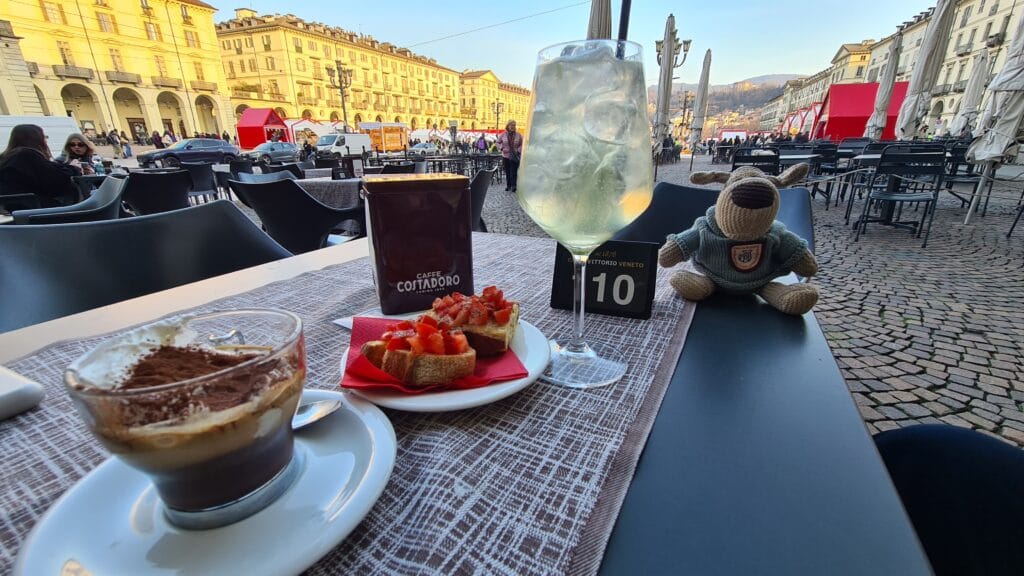
Andy, and his sweet tooth, had to try one. And so we finally found ourselves people-watching at one of the grand old cafés in Piazza Vittorio Veneto. The café itself has mixed reviews, but for location, atmosphere, and old-world charm, it was the perfect spot for a final drink in Turin.
Andy’s verdict? “The most luxurious mocha you’ll ever have.”
Just as well he liked it—because his bicerin and my Hugo Spritz came to 21 euros!
Tempted as we were (not at all) to stay for another, we set off towards the Mole Antonelliana for the grand finale of our trip.
 En route, we passed one of the city’s more unusual sights—the Fetta di Polenta (Slice of Polenta).
En route, we passed one of the city’s more unusual sights—the Fetta di Polenta (Slice of Polenta).
Of the two buildings in Turin designed by Alessandro Antonelli, they couldn’t be more different. Early in his career, Antonelli was given a small, oddly shaped plot of land—barely 17 feet wide at the front, narrowing to just 54 centimetres at the back.
With no option to expand, he built anyway. And when locals worried it would collapse, he moved in himself. That was in 1840. Nearly 185 years later, the polenta wedge is still standing.
His next project? The Mole Antonelliana.
Originally built as a synagogue, the Mole Antonelliana was later purchased by the city and now houses the National Museum of Cinema. It’s an icon of Turin, gracing the back of the two-euro coin, serving as the inspiration for the 2006 Winter Olympics logo, and even lending its name to one of Italian football’s fiercest rivalries—Il Derby della Mole, between Torino and Juventus.
But beyond all that, it’s simply impossible to ignore.
Standing at 167.5 metres, its spire pierces the skyline, visible from almost anywhere in the city. And for the best view? You have to go up.

It’s been on my bucket list for years, and finally, we made it. Excited is an understatement.
Taking the panoramic lift is an experience in itself. It rises through the centre of the dome, suspended dramatically above the museum exhibits below. A moment of mild vertigo, followed by 59 seconds of anticipation, and then—we stepped out, 85 metres above the city.
And wow.
The whole of Turin stretched out before us—red rooftops, elegant boulevards, and beyond the city, the Alps standing guard over it all. It’s cinematic, breathtaking, unforgettable.
With a perfectly clear sky, we had timed it just right for sunset, watching as the amber glow bathed the city in golden light.
The only way to end three incredible days in Turin.
If this city is not on your list, it should be.

Follow us on instagram @a2z.wander

A2Z Wander | Our Blog A Rainy Arrival (and a Slight Hangover) Lamezia Terme almost didn’t get its own blog post. There’s only so many
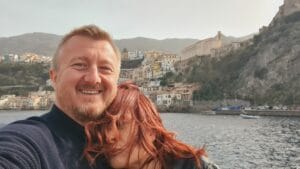
A2Z Wander | Our Blog A short coastal train ride punctuated by dramatic thunderclaps brought us further down into Calabria to a town called Scilla.
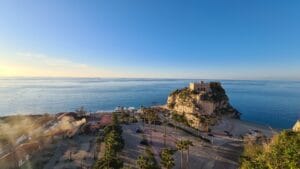
A2Z Wander | Our Blog This is quite the introduction to the town of Tropea… This is the view from Belvedere Piazza del Cannone in
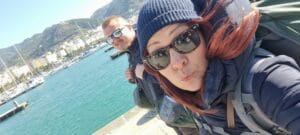
A2Z Wander | Our Blog Three weeks into the trip, and we were finally swapping wheels for waves, boarding our first boat along the coast
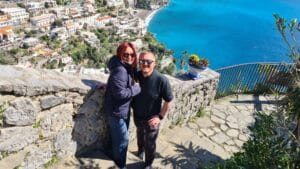
A2Z Wander | Our Blog With Sorrento in our rear-view mirror and the sea glittering to our right, we eased into the Amalfi Coast Drive,

A2Z Wander | Our Blog Naples left its indelible mark on us. We were sad to be leaving with so much still unexplored. But, if